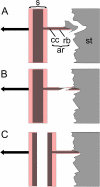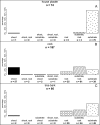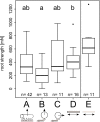Structure, attachment properties, and ecological importance of the attachment system of English ivy (Hedera helix)
- PMID: 21914660
- PMCID: PMC3245459
- DOI: 10.1093/jxb/err260
Structure, attachment properties, and ecological importance of the attachment system of English ivy (Hedera helix)
Abstract
Root climbers such as English ivy (Hedera helix) rely on specialized adventitious roots for attachment, enabling the plants to climb on a wide range of natural and artificial substrates. Despite their importance for the climbing habit, the biomechanical properties of these specialized adventitious roots compared with standard roots and their performance in the attachment to different host species or inert substrates have not been studied. Here organs and tissues involved in the attachment are characterized and their significance in regard to a broader functional and ecological aspect is discussed. Depending on the substrate, the root clusters show different types of failure modes at various frequencies, demonstrating the close interaction between the climber and its substrates. With a Young's Modulus of 109.2 MPa, the attachment roots are relatively stiff for non-woody roots. The central cylinders of the attachment roots show a high tensile strength of 38 MPa and a very high extensibility of 34%. In host trees naturally co-distributed with English ivy, a 'balanced' occurrence of failure of the attachment system of the climber and the bark of the host is found, suggesting a co-evolution of climber and host. Maximum loads of root clusters normalized by the number of roots match those of individually tested attachment roots. In comparison with most subterranean roots the properties and structure of the attachment roots of English ivy show distinct differences. There exist similarities to the properties found for roots of Galium aparine, suggesting a trend in not fully self-supporting plants towards a higher extensibility.
Figures






References
-
- Baker CJ, Berry PM, Spink JH, Sylvester-Bradley R, Griffin JM, Scott RK, Clare RW. A method for the assessment of the risk of wheat lodging. Journal of Theoretical Biology. 1998;194:587–603. - PubMed
-
- Bauer G, Speck T, Blömer J, Bertling J, Speck O. Insulation capability of the bark of trees with different fire adaptation. Journal of Material Science. 2010;45:5950–5959.
-
- Berry PM, Sterling M, Spink JH, Baker CJ, Sylvester-Bradley R, Mooney SJ, Tams AR, Ennos AR. Understanding and reducing lodging in cereals. Advances in Agronomy. 2004;84:217–271.
-
- Bruhn M. Beiträge zur experimentellen Morphologie, zur Biologie und Anatomie der Luftwurzeln. PhD thesis, Hohe Philiosophische Fakultät (Sektion II) der Kgl. 1909 Bayer. Ludwigs-Maximilians-Universität, Germany.
-
- Burgert I, Fruhmann K, Keckes J, Fratzl P, Stanzl-Tschegg SE. Microtensile testing of wood fibers combined with video extensometry for efficient strain detection. Holzforschung. 2003;57:661–664.

